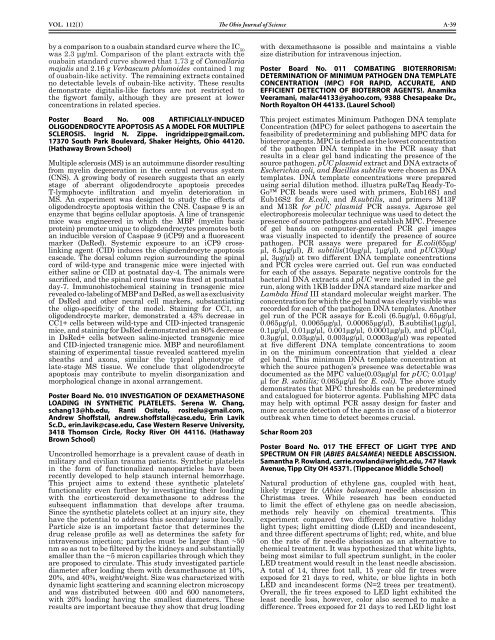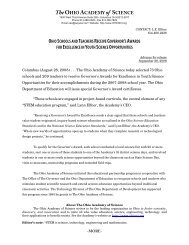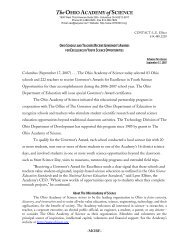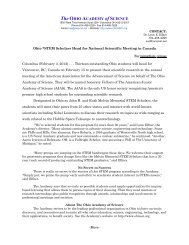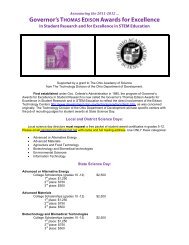The Ohio Journal of - The Ohio Academy of Science
The Ohio Journal of - The Ohio Academy of Science
The Ohio Journal of - The Ohio Academy of Science
You also want an ePaper? Increase the reach of your titles
YUMPU automatically turns print PDFs into web optimized ePapers that Google loves.
Vol. 112(1)<br />
by a comparison to a ouabain standard curve where the IC 50<br />
was 2.3 μg/ml. Comparison <strong>of</strong> the plant extracts with the<br />
ouabain standard curve showed that 1.73 g <strong>of</strong> Convallaria<br />
majalis and 2.16 g Verbascum phlomoides contained 1 mg<br />
<strong>of</strong> ouabain-like activity. <strong>The</strong> remaining extracts contained<br />
no detectable levels <strong>of</strong> oubain-like activity. <strong>The</strong>se results<br />
demonstrate digitalis-like factors are not restricted to<br />
the figwort family, although they are present at lower<br />
concentrations in related species.<br />
Poster Board No. 008 ARTIFICIALLY-INDUCED<br />
OLIGODENDROCYTE APOPTOSIS AS A MODEL FOR MULTIPLE<br />
SCLEROSIS. Ingrid N. zippe. ingridzippe@gmail.com.<br />
17370 South Park Boulevard, Shaker Heights, <strong>Ohio</strong> 44120.<br />
(Hathaway Brown School)<br />
Multiple sclerosis (MS) is an autoimmune disorder resulting<br />
from myelin degeneration in the central nervous system<br />
(CNS). A growing body <strong>of</strong> research suggests that an early<br />
stage <strong>of</strong> aberrant oligodendrocyte apoptosis precedes<br />
T-lymphocyte infiltration and myelin deterioration in<br />
MS. An experiment was designed to study the effects <strong>of</strong><br />
oligodendrocyte apoptosis within the CNS. Caspase 9 is an<br />
enzyme that begins cellular apoptosis. A line <strong>of</strong> transgenic<br />
mice was engineered in which the MBP (myelin basic<br />
protein) promoter unique to oligodendrocytes promotes both<br />
an inducible version <strong>of</strong> Caspase 9 (iCP9) and a fluorescent<br />
marker (DsRed). Systemic exposure to an iCP9 crosslinking<br />
agent (CID) induces the oligodendrocyte apoptosis<br />
cascade. <strong>The</strong> dorsal column region surrounding the spinal<br />
cord <strong>of</strong> wild-type and transgenic mice were injected with<br />
either saline or CID at postnatal day-4. <strong>The</strong> animals were<br />
sacrificed, and the spinal cord tissue was fixed at postnatal<br />
day-7. Immunohistochemical staining in transgenic mice<br />
revealed co-labeling <strong>of</strong> MBP and DsRed, as well as exclusivity<br />
<strong>of</strong> DsRed and other neural cell markers, substantiating<br />
the oligo-specificity <strong>of</strong> the model. Staining for CC1, an<br />
oligodendrocyte marker, demonstrated a 43% decrease in<br />
CC1+ cells between wild-type and CID-injected transgenic<br />
mice, and staining for DsRed demonstrated an 80% decrease<br />
in DsRed+ cells between saline-injected transgenic mice<br />
and CID-injected transgenic mice. MBP and neur<strong>of</strong>ilament<br />
staining <strong>of</strong> experimental tissue revealed scattered myelin<br />
sheaths and axons, similar the typical phenotype <strong>of</strong><br />
late-stage MS tissue. We conclude that oligodendrocyte<br />
apoptosis may contribute to myelin disorganization and<br />
morphological change in axonal arrangement.<br />
Poster Board No. 010 INVESTIGATION OF DEXAMETHASONE<br />
LOADING IN SYNTHETIC PLATELETS. Serena W. Chang,<br />
schang13@hb.edu, Ranti Ositelu, rositelu@gmail.com,<br />
Andrew Sh<strong>of</strong>fstall, andrew.sh<strong>of</strong>fstall@case.edu, Erin Lavik<br />
Sc.D., erin.lavik@case.edu, Case Western Reserve University,<br />
3418 Thomson Circle, Rocky River OH 44116. (Hathaway<br />
Brown School)<br />
Uncontrolled hemorrhage is a prevalent cause <strong>of</strong> death in<br />
military and civilian trauma patients. Synthetic platelets<br />
in the form <strong>of</strong> functionalized nanoparticles have been<br />
recently developed to help staunch internal hemorrhage.<br />
This project aims to extend these synthetic platelets’<br />
functionality even further by investigating their loading<br />
with the corticosteroid dexamethasone to address the<br />
subsequent inflammation that develops after trauma.<br />
Since the synthetic platelets collect at an injury site, they<br />
have the potential to address this secondary issue locally.<br />
Particle size is an important factor that determines the<br />
drug release pr<strong>of</strong>ile as well as determines the safety for<br />
intravenous injection; particles must be larger than ~50<br />
nm so as not to be filtered by the kidneys and substantially<br />
smaller than the ~5 micron capillaries through which they<br />
are proposed to circulate. This study investigated particle<br />
diameter after loading them with dexamethasone at 10%,<br />
20%, and 40%, weight/weight. Size was characterized with<br />
dynamic light scattering and scanning electron microscopy<br />
and was distributed between 400 and 600 nanometers,<br />
with 20% loading having the smallest diameters. <strong>The</strong>se<br />
results are important because they show that drug loading<br />
<strong>The</strong> <strong>Ohio</strong> <strong>Journal</strong> <strong>of</strong> <strong>Science</strong> A-39<br />
with dexamethasone is possible and maintains a viable<br />
size distribution for intravenous injection.<br />
Poster Board No. 011 COMBATING BIOTERRORISM:<br />
DETERMINATION OF MINIMUM PATHOGEN DNA TEMPLATE<br />
CONCENTRATION (MPC) FOR RAPID, ACCURATE, AND<br />
EFFICIENT DETECTION OF BIOTERROR AGENTS!. Anamika<br />
Veeramani, malar44133@yahoo.com, 9388 Chesapeake Dr.,<br />
North Royalton OH 44133. (Laurel School)<br />
This project estimates Minimum Pathogen DNA template<br />
Concentration (MPC) for select pathogens to ascertain the<br />
feasibility <strong>of</strong> predetermining and publishing MPC data for<br />
bioterror agents. MPC is defined as the lowest concentration<br />
<strong>of</strong> the pathogen DNA template in the PCR assay that<br />
results in a clear gel band indicating the presence <strong>of</strong> the<br />
source pathogen. pUC plasmid extract and DNA extracts <strong>of</strong><br />
Escherichia coli, and Bacillus subtilis were chosen as DNA<br />
templates. DNA template concentrations were prepared<br />
using serial dilution method. illustra puReTaq Ready-To-<br />
Go PCR beads were used with primers, Eub16S1 and<br />
Eub16S2 for E.coli, and B.subtilis, and primers M13F<br />
and M13R for pUC plasmid PCR assays. Agarose gel<br />
electrophoresis molecular technique was used to detect the<br />
presence <strong>of</strong> source pathogens and establish MPC. Presence<br />
<strong>of</strong> gel bands on computer-generated PCR gel images<br />
was visually inspected to identify the presence <strong>of</strong> source<br />
pathogen. PCR assays were prepared for E.coli(65µg/<br />
µl, 6.5µg/µl), B. subtilis(10µg/µl, 1µg/µl), and pUC(30µg/<br />
µl, 3µg/µl) at two different DNA template concentrations<br />
and PCR cycles were carried out. Gel run was conducted<br />
for each <strong>of</strong> the assays. Separate negative controls for the<br />
bacterial DNA extracts and pUC were included in the gel<br />
run, along with 1KB ladder DNA standard size marker and<br />
Lambda Hind III standard molecular weight marker. <strong>The</strong><br />
concentration for which the gel band was clearly visible was<br />
recorded for each <strong>of</strong> the pathogen DNA templates. Another<br />
gel run <strong>of</strong> the PCR assays for E.coli (6.5µg/µl, 0.65µg/µl,<br />
0.065µg/µl, 0.0065µg/µl, 0.00065µg/µl), B.subtilis(1µg/µl,<br />
0.1µg/µl, 0.01µg/µl, 0.001µg/µl, 0.0001µg/µl), and pUC(µl,<br />
0.3µg/µl, 0.03µg/µl, 0.003µg/µl, 0.0003µg/µl) was repeated<br />
at five different DNA template concentrations to zoom<br />
in on the minimum concentration that yielded a clear<br />
gel band. This minimum DNA template concentration at<br />
which the source pathogen’s presence was detectable was<br />
documented as the MPC value(0.03µg/µl for pUC; 0.01µg/<br />
µl for B. subtilis; 0.065µg/µl for E. coli). <strong>The</strong> above study<br />
demonstrates that MPC thresholds can be predetermined<br />
and catalogued for bioterror agents. Publishing MPC data<br />
may help with optimal PCR assay design for faster and<br />
more accurate detection <strong>of</strong> the agents in case <strong>of</strong> a bioterror<br />
outbreak when time to detect becomes crucial.<br />
Schar Room 203<br />
Poster Board No. 017 THE EFFECT OF LIGHT TYPE AND<br />
SPECTRUM ON FIR (Abies bAlsAmeA) NEEDLE ABSCISSION.<br />
Samantha P. Rowland, carrie.rowland@wright.edu, 747 Hawk<br />
Avenue, Tipp City OH 45371. (Tippecanoe Middle School)<br />
Natural production <strong>of</strong> ethylene gas, coupled with heat,<br />
likely trigger fir (Abies balsamea) needle abscission in<br />
Christmas trees. While research has been conducted<br />
to limit the effect <strong>of</strong> ethylene gas on needle abscission,<br />
methods rely heavily on chemical treatments. This<br />
experiment compared two different decorative holiday<br />
light types; light emitting diode (LED) and incandescent,<br />
and three different spectrums <strong>of</strong> light; red, white, and blue<br />
on the rate <strong>of</strong> fir needle abscission as an alternative to<br />
chemical treatment. It was hypothesized that white lights,<br />
being most similar to full spectrum sunlight, in the cooler<br />
LED treatment would result in the least needle abscission.<br />
A total <strong>of</strong> 14, three foot tall, 15 year old fir trees were<br />
exposed for 21 days to red, white, or blue lights in both<br />
LED and incandescent forms (N=2 trees per treatment).<br />
Overall, the fir trees exposed to LED light exhibited the<br />
least needle loss, however, color also seemed to make a<br />
difference. Trees exposed for 21 days to red LED light lost


